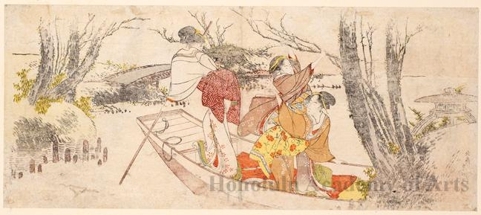葛飾北斎による浮世絵「Girls Boating」
作者:葛飾北斎
作品名:Girls Boating
制作年:1797
詳細:詳細情報...
情報源:ホノルル美術館
浮世絵(全 5,476 件)を表示...
説明:
From the late 1790s to the 1820s, before he released the famous landscape print series, Thirty-six Views of Mt. Fuji (ca. 1830-35), Hokusai produced many surimono (prints made for special occasions) for kyöka poetry. Kyöka is characterized by light and witty, thirty-one-syllable verses. Thus, during this time, Hokusai was better known as a kyöka print artist than a landscape artist. In 1795, after leaving the Katsukawa School, Shunrö (Hokusai) took the name of Tawaraya Söri and was active in new field until around 1798. The name, Tawaraya, to which he succeeded was that of the head of a school of painters carrying o the decorative tradition of the Rinpa. Although there are no records showing a link between Hokusai and this school, Söri (Hokusai) developed his own style. With pictures of women as seen here, for example, he favored the sleder, graceful type of women with oval faces and widow's peaks-the type popularly recognized under the name of “Söri beauty.” (from Hokusai His Students exhibition 1/30/2007-) ******************** Hokusai’s skill as a print designer is most eloquently expressed in his designs for privately commissioned surimono such as this, which were printed in small editions using the finest materials. Bijinga (pictures of beautiful women) was a prominent subject for Hokusai from the mid-1790s through the next two decades. The beginning of this period marks a change in Hokusai’s artistic identity, as he began to use the name Söri (from 1795 to around 1798). During the Söri period, Hokusai specialized in surimono, often commissioned by private kyöka (comic verse) poetry circles with which he was involved, as indicated on the inscriptions accompanying many of the works. This print is an early example of Hokusai’s efforts to combine figures as his primary subjects with prominently portrayed landscape backgrounds, which Richard Lane distinguished from his later “landscapes with figures” as “figures in a landscape.” This would eventually lead to the increasing importance of landscape elements seen in his later works, such as the Thirty-six Views of Mount Fuji. The print also provides evidence of Hokusai’s early experiments with Western perspective, most noticeably in the bridge connecting the mid-ground and background. “Hokusai’s Summit: Thirty-six Views of Mount Fuji” (09/24/2009-01/06/2010) ******************************
